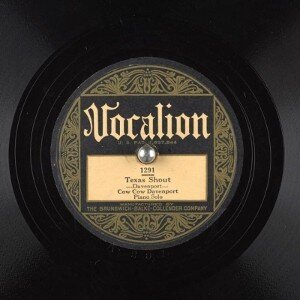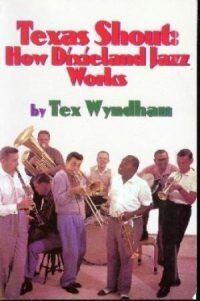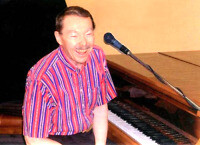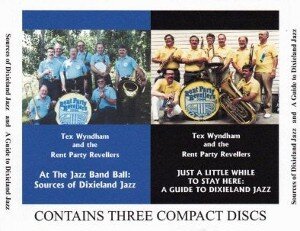 Set forth below is the thirtieth “Texas Shout” column. It first appeared in the July 1992 issue of the West Coast Rag, (now Syncopated Times)
Set forth below is the thirtieth “Texas Shout” column. It first appeared in the July 1992 issue of the West Coast Rag, (now Syncopated Times)
In the previous “Texas Shout,” I expressed my view that the heart and soul of Dixieland jazz is playing so that the music swings with heat. I suggested that each bandleader remember to choose a repertoire that gives his lineup, in light of its overall capabilities, the best chance of achieving this objective. (Read it Here.)
Let’s suppose that you’re a bandleader who is blessed with a band that knows how to swing with heat — no small achievement in a field that currently contains a discouragingly large number of combos which apparently have not yet grasped that, without those two elements, they can’t be considered to be playing jazz. Now that you’ve put your group solidly onto the level occupied only by jazz bands, how do you work your way up out of the crowd?
That one’s easy. You use imagination — creativity — in your performances. You put as many elements into your music, and its setting, as possible that will distinguish it from the other contenders without diminishing its jazz content.
There are plenty of bands out there that are not bothering to be imaginative. All of the greats of Dixieland have their imitators. Devotees of Turk Murphy are everywhere, replicating Turk’s recordings and/or solos. The same can be said of George Lewis, Lu Watters, King Oliver and a host of immortal names.
There is nothing wrong with doing so. On the other hand, as I will amplify below, trying to replicate what someone else has already done adds nothing significant to the already existing body of Dixieland jazz.
If you want to be remembered as a superior practitioner of any art form, you must find your own voice within it. Everybody knows who painted the original Mona Lisa, but can any of you name a single one of the thousands of artists who have made copies of it? Dixieland jazz works exactly the same way.
The elements of a performance are (1) presentation (if you’re appearing live), (2) the tunes that are played and (3) the way those tunes are rendered. Each of these elements can be handled creatively.
With respect to the non-musical aspects of a presentation, I have already written (see “Texas Shout” for August 1990) that a band can help its musical show considerably by paying attention to the setting in which the music appears, by finding a way to keep the audience entertained. I won’t elaborate on this topic again but will note that, given two bands whose musical presentations are identical, I will certainly choose to go to see the one that has the most colorful and engaging presentation of that music.
However, because I am principally attracted to Dixieland jazz as an art form, I will always prefer to see a band that plays better jazz, even if its presentation is less enticing. I would hope that Dixieland fans, as they develop experience with the music and a heightened awareness of its many rewards, would over the long haul tend to agree with that viewpoint. Thus, let’s talk for the rest of this column about increasing creativity within the music.
Of the two remaining elements, repertoire and performance, performance is beyond question the most important. To illustrate what I mean, let’s consider four bands, each with identical abilities to swing with heat.
At the bottom of the ranking will be the band that plays the same old tunes the same old way. Just above the bottom will be the band that plays a highly imaginative, well-chosen repertoire, but plays it the same old way — running changes, using a limited palette of sound textures, giving us the same things we’ve heard thousands of times but on somewhat different melodies and chord patterns.
Ahead of that band, nearing the top of the heap, will be the combo that plays the same old tunes, but in a highly imaginative way — giving us fresh ideas from the soloists, novel voicings and different instrumental textures, causing the seemingly familiar numbers to emerge in brand new costumes. To underscore that point, and to state precisely what’s meant here, a fresh, varied ride, with fertile solos, empathetic interplay among the sidemen, and distinctive ensemble effects on, say, “When The Saints Go Marching In,” is a superior work of art within the idiom than a rendition of “Elephant Wobble” in which the soloists, playing in their usual sequence, trot out once again their favorite licks.
At the top of the pile, of course, is the group that does both. This will be a combo that looks for worthwhile but underplayed material, but which always remembers to approach every selection, whether familiar or not, as a challenge for finding something musically new and valid to say.
This ranking reflects a point I have made from time to time in various editions of “Texas Shout,” but it is one that we shouldn’t forget if we care about Dixieland as an art form. Namely, from an artistic viewpoint, the musical performance is everything.
Tunes are inanimate collections of notes. They do not know whether they have already been played thousands of times by Dixielanders, or whether they have just been rediscovered.
Despite what many players and fans think, tunes do not become “exhausted” through being played frequently. A piece that was a superior vehicle for Dixieland in the twenties or thirties is just as superior now, provided we remember to bring to it an imaginative, searching spirit.
Said another way, a mediocre ride is mediocre no matter how you slice it. It does not become less mediocre because the vehicle chosen is a newly resurrected, underplayed gem of a composition. Similarly, a hot, swinging, imaginative ride does not become less interesting artistically because the vehicle chosen has been played and recorded many times in the past.
How does a bandleader go about fostering creativity? With respect to soloing, there’s not much you can do directly. You’re ultimately dependent on the degree to which your individual sidemen are willing to stretch themselves in order to find new things to say and avoid favorite licks.
(Read: Texas Shout #15 How to Improvise Solos)
However, you can do some things that will stimulate the juices within the ranks. Vary the tempos and keys from tune to tune. Call the solos in a different order. Try part-chorus solos occasionally.
With respect to harmonies, Dixieland is fairly basic in that respect and you can’t do very much modification without moving into advanced jazz forms. However, you can look for more interesting voicings of your horn passages, perhaps by assigning the melody to some instrument other than the usual cornet lead.
Dynamics is an overlooked area for creativity. The imaginative juxtaposition of loud and soft passages can be a sure-fire ear-catcher for the audience.
In routines, though, the field is wide open. Must the strains always be played in the usual order on this title? Does it offer an opportunity for a subunit? Does the tune have several strains that are suitable solo platforms, so that you can have some solos on one and then move to another for the remainder? Can you find new places for breaks, stop-time passages, key changes, special interludes, arranged effects and the like? Does the song have a good but underutilized lyric? Can you develop a special introduction and tag for it?
Let me mention two examples I’ve noticed where, I think, it’s time for a little more creativity to appear on our stages: Duke Ellington’s “The Mooche” and Lu Watters’ “Doin’ The Hambone.”
“The Mooche” is one of the all-time-great mood pieces of Dixieland exotica. I’m not at all surprised that so many combos have been attracted to it.
However, and I’m speaking as one who has reviewed many renditions of this selection, virtually everybody delivers the Ellington chart nearly verbatim when they get around to executing “The Mooche.” Did Ellington really say, over sixty years ago, everything that could possibly be said about this tune, leaving us with nothing to do through the following decades but regurgitate his effort?
Frankly, I’ve heard so many Ellington clones on “The Mooche” that I have to struggle to pay attention and take notes on the review copies. Once that “dum-da-da-da-dum” tom-tom starts, I can tell myself that I know exactly what’s going to happen for the next three or four minutes, and I’m almost always right. Same problem with the few combos I’ve played with that perform “The Mooche” — their charts are so firmly locked into Ellington, so lacking in novelty, that it’s all I can do to keep from going to sleep at the keyboard.
I don’t know about the rest of the audience, but your band could sure hold my attention if you, say, opened “The Mooche” with a duet on the minor blues strain, added instruments for a couple of choruses as you build up to a full ensemble for the descending C-minor strain, took a few more choruses on the major blues strain, and ended with the major blues riff strain, closing with a clarinet cadenza into a sustained minor chord. How would that rendition work? Darned if I know, but it would be thought-provoking and your version instead of Ellington’s.
“Doin’ The Hambone” has not been as widely waxed, probably because it is not one of Watters’ best compositions, ranking well below his three masterpieces, “Emperor Norton’s Hunch,” “Big Bear Stomp” and the underplayed “Antigua Blues.” Still, Watters’ rendition chugs along well enough, and I can see why his disciples keep it alive.
However, in “Doin’ The Hambone,” Watters did not write a tune; he wrote a routine. There is very little melody to the number, which consists primarily of a series of themes in which stop-time licks occur in varied spots.As best I can recall, all of the post-Watters recordings I’ve encountered of “Doin’ The Hambone” render the tune exactly per the Watters original, even to the point of having the one solo played on the piano. Couldn’t one of the stop-time strains be smoothed out for a solo? What would happen if some breaks were put into the main strain instead of the later ones? Could any theme be made more effective if it were played at a volume significantly below the quadruple forte heard on all of Watters’ sides? So far, it appears that we aren’t going to be given the opportunity to find out.
In effect, the renditions we’re hearing of these numbers are not those of the bands playing them. We’re hearing Ellington’s and Watters’ renditions. These tunes are being used almost exclusively as repertory numbers.
Repertory is a special concept within Dixieland that is exempt from the creativity requirement. It consists of a more or less conscious effort to duplicate a performance that appears on a previous recording. Creativity in a repertory performance defeats its purpose.
I can see some value in repertory Dixieland. If Oliver, Bix, Louis, Turk, Bunk, Wild Bill and the other are no longer around to play their great creations for us, and if their creations are truly the immortal performances we know them to be, there is something to be said for scoring them in a way that will let today’s audiences hear them live.
Repertory can be a valuable teaching tool, providing your sidemen, and others new to our music, with an accessible way of listening to acknowledged masterpieces of the idiom. It avoids the somewhat less immediate, colder activity of listening to records.
Also, many musicians derive satisfaction from executing someone else’s magnificent conceptions. As you have doubtless gathered, I am not a musician who personally prefers to play in that manner. However, this is strictly a question of taste, and I recognize that doing so constitutes a perfectly valid way to enjoy performing music.
Even so, executing repertory Dixieland is an artistically empty endeavor. If you can’t have the original Mona Lisa in your home, you may well be quite satisfied to appreciate a photograph of it, but nobody pretends that the photograph, in and of itself, has much artistic value.
When repertory bands produce records, this problem becomes especially focused. Granted, there may be some marginal benefits in hearing the music in present-day fidelity (although the miracles of modern sound techniques for cleaning up old records are making serious inroads into that advantage).
However, most of the great recordings of Dixieland are reissued with satisfying frequency. If I’m going to take a record off the shelf, I can’t really see why I’m going to select one by The Dixieland Repertory All-Stars that tries to sound like one by Turk Murphy, or King Oliver, of Jelly Roll Morton, or George Lewis, or Lu Watters, etc., when I can choose the original instead.
Much the same thing is true of live performances. If your band is one that does not try to be creative, that is content to duplicate essentially what you’ve heard on your favorite records, why should we get dressed up, go out of the house, and pony up the admission to listen to you when we can stay home, save ourselves the time and money, and hear the records you’re copying in the comfort of our living rooms?
The practitioners of the more advanced forms of jazz typically look down on today’s Dixieland community, calling it a group of hobbyists who have nothing of value to add to jazz. Although, as with most generalizations, this one is probably a bit too sweeping, there is a measure of truth in that accusation.
However, things don’t have to be that way. Dixieland is the same as it always was, an idiom that has plenty of room for timeless music.
Your band can get its head up above the pack by deciding to take a chance, to get imaginative, to try to create some of that timeless music instead of playing it safe. The rest of us can help by insisting on and applauding such efforts, and by applauding even louder when those efforts succeed.
Otherwise, we might as well concede that our critics are right, and Dixieland is just a sterile playground for hobbyists determined to recreate the past. I know which route I prefer.
Back to the Texas Shout Index.

The full run of “Texas Shout” has been collected into a lavishly illustrated trade paperback entitled Texas Shout: How Dixieland Jazz Works. This book is available @ $20.00 plus $2.95 shipping from Tex Wyndham, On request, Tex will autograph the book and add a personalized note (be sure to tell him to whom the note should be addressed).
Tex Wyndham’s 3 CD Guide to Dixieland with music and commentary is available for $20 plus $2.95 shipping. The separate CD, A History of Ragtime: Tex Wyndham Live At Santa Rosa, is available for $13.00 plus $2.00 shipping. On request, Tex will autograph the inner sleeve and add a personalized note (be sure to tell him to whom the note should be addressed).
Send payment to Tex Wyndham, P.O. Box 831, Mendenhall, PA 19357, Phone (610) 388-6330.
Note: All links, pictures, videos or graphics accompanying the Shouts were added at the discretion of the Syncopated Times editorial staff. They did not accompany the original columns and do not necessarily reflect the opinion of Tex Wyndham.
From roughly 1970-2010, Tex Wyndham was: (1) one of the best-known revivalist Dixieland jazz musicians in the US, as cornetist, pianist and bandleader, (2) one of the best-known ragtime pianists in the US, and (3) one of the most respected critics in the US of Dixieland jazz, ragtime, and related music. He is the only person about whom all three of those statements can be made.




